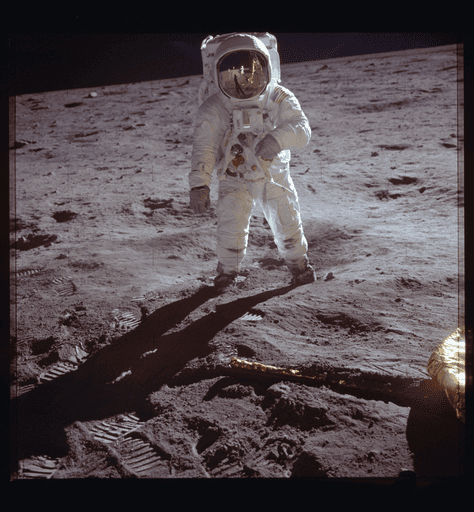STEP BY STEP. FEROCIOUSLY.
Gradatim Ferociter is a Latin phrase that translates to "Step by step ferociously" in English. It's our mantra Arcadea. It reminds us to be long-term ambitious, focus on controllable inputs, and put in the work to get 1% better every day. Day in and day out.
Examples of long-duration ferocity.
Many of our most remarkable feats throughout history have come from moving forward step by step ferociously. Here are a few examples of incredible feats that took consistent, long-term ferocity to accomplish.
Apollo Program (1961–1972). An ambitious U.S. effort that methodically advanced from early Mercury/Gemini flights to the first crewed Moon landing. NASA executed a series of incremental test missions (uncrewed Saturn V launches, orbital rendezvous, Lunar Module tests) that each had to succeed before moving to the next step . This relentless approach paid off when Apollo 11 achieved the historic goal in 1969, proving that diligent iteration and learning from setbacks (like the Apollo 1 fire) could turn a daring vision into reality .
Astronaut Buzz Aldrin on the Moon during Apollo 11 (1969), fulfilling President Kennedy’s lunar landing goal.
Lockheed SR-71 Blackbird. A record-shattering Mach 3+ spy plane developed in secret by a small “Skunk Works” team in the U.S. that overcame unprecedented engineering challenges. To survive sustained speeds over three times the speed of sound, engineers had to invent new materials and designs — for example, using titanium alloy skin to withstand 316 °C surface temperatures that would melt ordinary airframes . They solved countless problems (engines that could start and operate from 200 mph to 2,200 mph, preventing mid-flight flameouts, early stealth shaping) through iterative testing and innovation . The result was an aircraft decades ahead of its time, flying “ferociously” higher and faster than any other, a testament to persistent technical mastery.
Large Hadron Collider (2008–present). The world’s most powerful particle accelerator, built by CERN with over 10,000 scientists from 100+ countries, realized after 25 years of proposals, design and construction . Starting as an idea in the early 1980s, the LHC project faced technical challenges of mind-boggling scale: a 27-km circular tunnel, thousands of superconducting magnets cooled to near absolute zero, and detectors the size of buildings. Through stepwise innovation (each generation of collider — ISR, SPS, LEP — informed the next), teams steadily improved accelerator technology. The LHC finally launched in 2008, enabling discovery of the long-sought Higgs boson in 2012 . This success story showcases ferocious commitment — decades of incremental progress and problem-solving — to push the frontiers of physics, embodying “gradually, then suddenly” achieving the once-impossible.
Human Genome Project (1990–2003). A 13-year scientific marathon by an international consortium to map all 3 billion base pairs of human DNA. Led by U.S. agencies (NIH and DOE) alongside partners in the UK, France, Japan, Germany, China and others, the HGP exemplified gradual but ferocious progress in biotechnology . Researchers divided the seemingly insurmountable task into chunks, sequencing and assembling fragments chromosome by chromosome. Through improved automation, data sharing, and constant problem-solving, they went from identifying individual genes in the 1980s to publishing a draft genome by 2001 and a completed reference by 2003 . It was the largest collaborative biology project ever — a triumph of perseverance that has since revolutionized medicine and our understanding of life.
Examples of short-duration ferocity.
Long-duration ferocity does not mean that much can't be accomplished quickly. Ideally, ferocity over long spans of time is composed of ambitious short-term sprints. Speed and consistency compound over long spans of time. Here are a few of our favorite examples of incredible short-term ferocity to realize history-making feats.
Disneyland. Walt Disney's conception of "The Happiest Place on Earth" was brought to life in 366 days. Source: Under Construction: A look inside Walt Disney’s Disneyland.
P-80 Shooting Star. Kelly Johnson and his team designed and delivered the P-80 Shooting Star, the first jet fighter used by the USAF, in 143 days. Source: Skunk Works.
BankAmericard. Dee Hock was given 90 days to launch the BankAmericard card (which became the Visa card), starting from scratch. He did and in that period he signed up more than 100,000 customers as well. Source: Electronic Value Exchange.
The Eiffel Tower. The Eiffel Tower was built in 2 years and 2 months — that is, in 793 days. When completed in 1889, it became the tallest building in the world, a record it held for more than 40 years. It cost about $40 million in 2019 dollars. Source: Eiffel's Tower.
Apollo 8. On August 9 1968, NASA decided that Apollo 8 should go to the moon. It launched on December 21, 1968 — just 134 days later. Source: Apollo Spacecraft Chronology.

ARCADEA DISPATCH
Sign up for our free newsletter. Every month we share the big ideas we're studying across finance, technology, and science.
